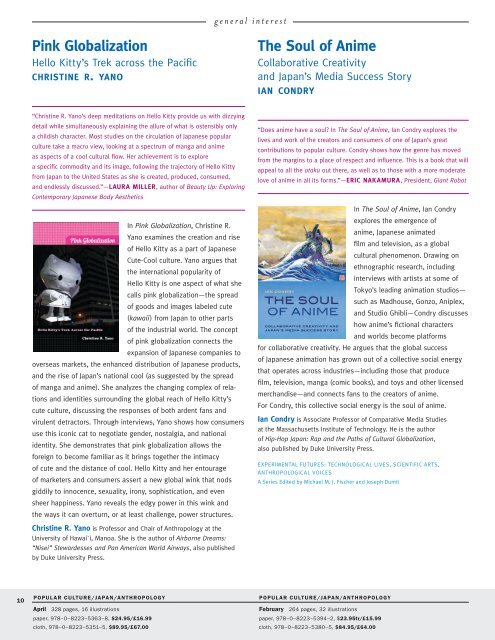Spring 2013 Catalog - Duke University Press
Spring 2013 Catalog - Duke University Press
Spring 2013 Catalog - Duke University Press
You also want an ePaper? Increase the reach of your titles
YUMPU automatically turns print PDFs into web optimized ePapers that Google loves.
10<br />
Pink Globalization<br />
Hello Kitty’s Trek across the Pacific<br />
christine r. yano<br />
“Christine R. Yano’s deep meditations on Hello Kitty provide us with dizzying<br />
detail while simultaneously explaining the allure of what is ostensibly only<br />
a childish character. Most studies on the circulation of Japanese popular<br />
culture take a macro view, looking at a spectrum of manga and anime<br />
as aspects of a cool cultural flow. Her achievement is to explore<br />
a specific commodity and its image, following the trajectory of Hello Kitty<br />
from Japan to the United States as she is created, produced, consumed,<br />
and endlessly discussed.”—LAURA MILLER, author of Beauty Up: Exploring<br />
Contemporary Japanese Body Aesthetics<br />
In Pink Globalization, Christine R.<br />
Yano examines the creation and rise<br />
of Hello Kitty as a part of Japanese<br />
Cute-Cool culture. Yano argues that<br />
the international popularity of<br />
Hello Kitty is one aspect of what she<br />
calls pink globalization—the spread<br />
of goods and images labeled cute<br />
(kawaii) from Japan to other parts<br />
of the industrial world. The concept<br />
of pink globalization connects the<br />
expansion of Japanese companies to<br />
overseas markets, the enhanced distribution of Japanese products,<br />
and the rise of Japan’s national cool (as suggested by the spread<br />
of manga and anime). She analyzes the changing complex of relations<br />
and identities surrounding the global reach of Hello Kitty’s<br />
cute culture, discussing the responses of both ardent fans and<br />
virulent detractors. Through interviews, Yano shows how consumers<br />
use this iconic cat to negotiate gender, nostalgia, and national<br />
identity. She demonstrates that pink globalization allows the<br />
foreign to become familiar as it brings together the intimacy<br />
of cute and the distance of cool. Hello Kitty and her entourage<br />
of marketers and consumers assert a new global wink that nods<br />
giddily to innocence, sexuality, irony, sophistication, and even<br />
sheer happiness. Yano reveals the edgy power in this wink and<br />
the ways it can overturn, or at least challenge, power structures.<br />
Christine R. Yano is Professor and Chair of Anthropology at the<br />
<strong>University</strong> of Hawai`i, Manoa. She is the author of Airborne Dreams:<br />
“Nisei” Stewardesses and Pan American World Airways, also published<br />
by <strong>Duke</strong> <strong>University</strong> <strong>Press</strong>.<br />
XXXXX/XXXXX POPULAR CULTURE/JAPAN/ANTHROPOLOGY<br />
STUDIES<br />
xxxx April xxx 328 pages pages, 16 illustrations<br />
paper, 978–0–8223–5114–6, 978–0–8223–5363–8, $22.95/£14.99<br />
$24.95/£16.99<br />
cloth, 978–0–8223–5100–9, 978–0–8223–5351–5, $79.95/£54.00<br />
$89.95/£67.00<br />
general interest<br />
The Soul of Anime<br />
Collaborative Creativity<br />
and Japan’s Media Success Story<br />
ian condry<br />
“Does anime have a soul? In The Soul of Anime, Ian Condry explores the<br />
lives and work of the creators and consumers of one of Japan’s great<br />
contributions to popular culture. Condry shows how the genre has moved<br />
from the margins to a place of respect and influence. This is a book that will<br />
appeal to all the otaku out there, as well as to those with a more moderate<br />
love of anime in all its forms.”—ERIC NAKAMURA, President, Giant Robot<br />
In The Soul of Anime, Ian Condry<br />
explores the emergence of<br />
anime, Japanese animated<br />
film and television, as a global<br />
cultural phenomenon. Drawing on<br />
ethnographic research, including<br />
interviews with artists at some of<br />
Tokyo’s leading animation studios—<br />
such as Madhouse, Gonzo, Aniplex,<br />
and Studio Ghibli—Condry discusses<br />
how anime’s fictional characters<br />
and worlds become platforms<br />
for collaborative creativity. He argues that the global success<br />
of Japanese animation has grown out of a collective social energy<br />
that operates across industries—including those that produce<br />
film, television, manga (comic books), and toys and other licensed<br />
merchandise—and connects fans to the creators of anime.<br />
For Condry, this collective social energy is the soul of anime.<br />
Ian Condry is Associate Professor of Comparative Media Studies<br />
at the Massachusetts Institute of Technology. He is the author<br />
of Hip-Hop Japan: Rap and the Paths of Cultural Globalization,<br />
also published by <strong>Duke</strong> <strong>University</strong> <strong>Press</strong>.<br />
EXPERIMENTAL FUTURES: TECHNOLOGICAL LIVES, SCIENTIFIC ARTS,<br />
ANTHROPOLOGICAL VOICES<br />
A Series Edited by Michael M. J. Fischer and Joseph Dumit<br />
XXXXX/XXXXX POPULAR CULTURE/JAPAN/ANTHROPOLOGY<br />
STUDIES<br />
xxxx February xxx pages 264 pages, 32 illustrations<br />
paper, paper, 978–0–8223–5114–6, 978–0–8223–5394–2, $22.95/£14.99<br />
$23.95tr/£15.99<br />
cloth, cloth, 978–0–8223–5100–9, 978–0–8223–5380–5, $79.95/£54.00<br />
$84.95/£64.00












